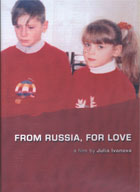
From Russia, For Love 2008
Distributed by Interfilm Productions Inc.,, 304-1515 West Hastings St., Vancouver, BC V6G 3G6, Canada; 604-638-8920
Produced by Julia Ivanova
Directed by Julia Ivanova
DVD, color, 53 min.
College - Adult
Adoption, Russia, Sociology
Date Entered: 11/18/2009
Reviewed by Andrew Jenks, California State University, Long BeachJulia Ivanova specializes in films which document North American relations with the Russian Federation. Her 2006 film, Moscow Freestyle, examined these relations through the prism of twenty-something Americans and Canadians who traveled to Moscow to teach English – and to find love, friendship, and adventure. In From Russia, For Love, Ivanova has chosen a different perspective: the relationship between two Canadian families and their adopted older children from Russia. Shot over the course of three years, the images are by turns moving and profound.
Ivanova heightens the suspense and drama of her film by following the story chronologically, from the adoption of the children in a provincial Russia orphanage to settling in with their new families in Canada. When the parents meet their new children in the Russian orphanage, it is not clear if the adoption will end in tragedy or triumph – or some complex mix of the two. The adopted children are not infants, but seven-year olds with vivid and painful memories of abandonment by parents and separation from siblings. The children can barely speak a word of English and the new parents know little Russian. In the case of one family, a disastrous outcome seems likely when the new parents decide to change their adoptee’s name from Olga to Kira, as if changing a name could erase seven years of a child’s life and create a fresh start. The viewer then learns that the new “Kira” has numerous siblings, including a 12-year-old older brother named Dmitrii at the same orphanage. The siblings rely on each other for support and love, so the adoption of Kira marks her entrance into a new family but also the destruction of what is left of her birth family back in the orphanage.
To shed light on this seemingly cruel act of separating “Kira” from her sibling, Ivanova introduces the viewer to a Russian orphanage official. The official recounts the sobering statistics of children who grow up in Russian orphanages and enter the adult world. One in three becomes homeless. One in five ends up in a Russian prison. One in ten commits suicide. Children in orphanages, added the orphanage official, come to depend on the state for everything. “Orphans are as helpless as blind kittens when they enter the adult world,” says the narrator. So it’s a good thing, under almost any circumstance, for a child to be adopted into a stable family, no matter how painful the separation from the orphanage.
Amazingly, the adoptees within three months in their new Canadian homes seem to have nearly mastered English – an astounding testimonial to the innate language abilities of children. Kira, formerly Olga, has not only taken to her new Canadian home and environment, but she has managed to convince her new parents to bring her brother to Canada – and then another brother!
Ivanova’s tactful and gentle prodding and questioning of her young subjects reflects her expertise as an adoption coordinator. A Russian émigré herself, she also has an instinct for focusing on the issues that most challenge adoptees from the Russian Federation.
This relatively short documentary might have benefitted from the perspective of more Russians regarding the phenomenon of North Americans adopting Russian children. Given the demographic crisis in Russia (its population, by some estimates, is shrinking by hundreds of thousands every year) the adoption of Russian children by the former “enemy” has become an explosive political issue. I wonder about the perspective of the caregivers at the orphanage, who are clearly upset when the newly adopted children are taken away from them by their new Canadian families. What did they think of the adoptions? Why is it that no Russian families were willing to adopt these children?
Providing more of a comparative perspective would have also helped clarify the uniqueness of the Russian adoption system. Is the Russian process of putting children up for adoption unique? How is it similar or different from the process of adopting children from orphanages, say, in Canada or the United States?
All in all, however, Ivanova has provided a moving and informative window into the fascinating process of adopting older children and bringing them into an alien culture and society for which they have no preparation. The film has a potentially broad classroom audience – from courses in child psychology and contemporary Russia to programs in child development and sociology.